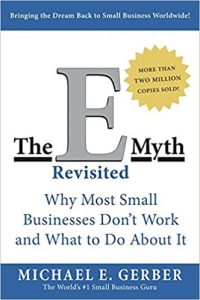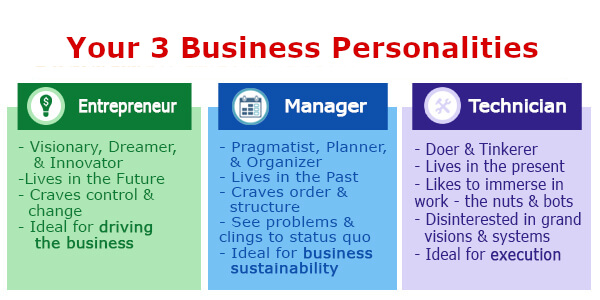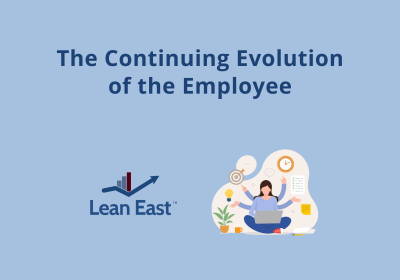
The Entrepreneurial Myth (E-Myth) has had a profound cost in America – in lost resources, lost opportunities, and wasted lives.
Most small business owners are not venture capital-funded tech companies, despite what we hear about on the news. The majority of businesses get started because employees who are strong at their craft technically become frustrated and feel unappreciated by their employers. These carpenters, mechanics, programmers, cooks, barbers, doctors, plumbers, graphic designers, engineers, etc. get the “entrepreneurial itch” to ditch their worthless boss and call their own shots.
Most of these new businesses fail within the first few years due to a misconception about entrepreneurship. The fatal assumption is:
“if you understand the technical work of a business, you understand a business that does that technical work.”
Why Most Small Businesses Don’t Work and What to Do About It
This is a summary of key lessons from the 1995 book, The E-Myth Revisited: Why Most Small Businesses Don’t Work and What to Do About It by Michael Gerber. We want all aspiring entrepreneurs to understand the Entrepreneurial-myth before they quit their job to start a new business.

I am writing this summary as a serial entrepreneur myself. I founded Lean East back in 2010 and have also been a part of several other start-up or early-stage companies. I’ve presented at numerous entrepreneurial conferences, mentored and judged start-ups, and advised many small business owners over the past ten years. Along the way, I have had the opportunity to experience major success while also learning from mistakes made.
This summary will cover the three phases of a business’s growth as described in The Entrepreneurial Myth (E-Myth) Revisited:
- Infancy
- Adolescence
- Maturity
The Phases of Growth: Infancy
In the infancy stage, you are the business. If you are a baker, you are making some pies that you sell at local stores. If you are a roofer, you are buying materials and replacing the roof yourself. When you begin your business with good technical skills, you can get off the ground.

After a short time, the baker realizes they can make more money if they have a small pie shop and some employees to help them with baking. The roofer hires a small crew to fix the roofs for a few more customers. Right away, the entrepreneur realizes that the employees replacing them do not have the same technical skills they do. Mistakes happen, and customers get angry.
Business infancy ends when the owner realizes they need to manage the business rather than be the business. For many technicians, this is too far out of their comfort zone and they walk away from the business at this stage. The others move on to the second stage of growth: adolescence.
“Most businesses operate according to what the owner wants, not what the business needs.”
The Phases of Growth: Adolescence
There’s a critical moment in every growing business when the owner gets too busy and hires the first person to do the work he/she doesn’t know how to do themselves (or doesn’t want to do themselves). This may be a bookkeeper, a business improvement consultant, or a general manager. The new person adds a different strength and helps manage the growth so the owner can relax and enjoy the business again.
Unfortunately, the new person will still need to be managed. Owners who continue to resist managing will see the business continue to grow beyond their comfort zone, until they either return to infancy (get small again), crash and burn, stay in survival mode, or move on to maturity.
I worked at one company that expanded past the owner’s comfort zone. He slowed the growth of the company and cut staff until he felt it was “manageable” to him again. This obviously had a large negative effect on the employees and the community.
I have also observed several of my suppliers crash and burn – continue to grow out of control (and loosely managed) until they make a major mistake that bankrupts the business.
Survival Mode
Staying in survival mode is very common for small restaurants, barbershops, and service providers. I have worked with too many owners that do not account for the value of their own work.

For example, I know several restaurants where the owner works for 60 hours per week as the general manager but doesn’t pay him/herself a regular paycheck. If the owner were paid as an employee (instead of from the profits of the business) they would be making $100,000 per year for their hours worked plus overtime. Instead, the business ends the year with about $100,000 in profit.
The net result is an owner who may as well have a boss: the business! If the owner wanted to hire a replacement, the business would not be profitable!
“Build a business that works without you, not because of you.”
The Phases of Growth: Maturity
The maturity phase is exemplified by the best businesses in the world. In this stage, the work itself isn’t important, the business is important. Some owners survive the infancy and adolescence stages and become mature, but other businesses start out that way!
The owners of mature companies can think like a technician and a manager, but also must think like a true entrepreneur. Mature companies ask the right questions:
- What is my why? My vision?
- What is the why and vision for the business?
- Who is our customer and what value are they willing to pay for?
- How must the business work? What are our systems?
Entrepreneurs of mature companies work on the business, not in it. Their goal is to create a business that is system-dependent, not people-dependent. The business should be able to operate without them.

Become “Franchise Ready”
The remainder of the book consists of suggestions for building a small business that works.
As a business owner, the primary goal should be to build your business so that it will provide consistent customer value no matter who is providing the work. It is key to develop an operations manual that defines the procedures that produce consistent results.
“Prepare your business so that you can turn it into a franchise.”
The author shares the story of Ray Kroc and the McDonalds brothers. As we all know, the world has many restaurants that serve simple hamburgers and fries. The “secret sauce” for McDonald’s is that they have developed a system that can turn inexperienced workers into producers of fast, consistent, great-tasting, and highly profitable burgers. The Mcdonald’s franchise knows where to locate their restaurants, how to design and build the building, how to staff, how to purchase, how to price, how to market – all the key steps in running a successful Mcdonald’s restaurant.
Here is a fun video clip from the movie The Founder that shares how the McDonald brothers attempted to build a better business, not just a better burger.
The Entrepreneurial Myth (E-Myth)
We hope you enjoyed our summary of The E-Myth Revisited: Why Most Small Businesses Don’t Work and What to Do About It by Michael Gerber. Please connect with Lean East if you need some help moving your small business to the next stage of growth.
Leave your comments and suggestions below.




